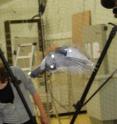Want to fly? Don't copy the birds and the bees
Since earliest recorded history, and presumably beyond, humans have always wanted to fly. First attempts involved imitation of winged creatures around them, and unfailingly ended in disaster. No workable flying machines have ever looked particularly similar to nature's fliers, and today there is little comparison between a top of the range military chopper and the humble bumblebee, despite similar flight patterns. In an era in which engineers are increasingly exploiting designs from nature, understanding this paradox is becoming ever more important. Dr Jim Usherwood, from the Royal Veterinary College, has studied the reasons behind these differences in aerodynamics and concluded that scientists should, in this instance, be more hesitant before imitating nature. He will be presenting his results on Sunday 6th July at the Society for Experimental Biology's Annual Meeting in Marseille [Session A3]. Dr Usherwood believes the reason that flying creatures don't look like man made machines is all to do with the need to flap. "Animals' wings, unlike propellers, have to keep stopping and starting in order produce lift (animals have forgotten to invent propellers, just as they forgot wheels)," he explains. "Think of vigorous waving, or perhaps exuberant rattling of a cocktail shaker - this takes a fair amount of power to overcome inertia. So, the idea is that both wing shape and how wings are used can be understood better if the effort of flapping is remembered, which explains why vultures don't look like gliders, and most winged creatures, from insects to pigeons, fly so inefficiently."
His research has centred on creatures as diverse as dragonflies and quails. Currently he is investigating the compromise winged creatures face between meeting aerodynamic requirements and overcoming inertia in order to generate lift, by loading wings of racing pigeons with lead fishing weights. He believes that lessons from all of these studies lead to the same conclusion. "My work should act as a reminder to be cautious in copying nature. There is lots of interest in making MAVs/UAVs (micro/unmanned air vehicles) that flap, which may present all sorts of advantages in terms of maneuverability, speed and so on. However, there is a tendancy to presume that biology is efficient, and I would say that, even at very small sizes, if you want to hover efficiently, be a helicopter not a flapper…"
Source: Society for Experimental Biology
Other sources
- Want to fly? Don't copy the birds and the beesfrom PhysorgSun, 6 Jul 2008, 7:28:20 UTC
- Want To Fly? Don't Copy The Birds And The Beesfrom Science DailySun, 6 Jul 2008, 2:14:17 UTC
